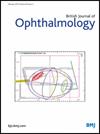Association of leucocyte telomere length with incident age-related macular degeneration: a prospective UK Biobank Study
IF 3.5
2区 医学
Q1 OPHTHALMOLOGY
引用次数: 0
Abstract
Purpose There have been conflicting findings on the role of leucocyte telomere length (LTL) in the risk of age-related macular degeneration (AMD). In this study, we evaluated the associations between LTL and the risk of incident AMD and explored whether age, sex and/or genetic predisposition to AMD can modify these associations. Methods We conducted a longitudinal cohort study involving 332 123 AMD-free participants with complete baseline covariates and LTL data from the UK Biobank. We employed multivariable Cox proportional hazards models to test the association between LTL and AMD incidence, estimating the HRs and 95% CIs. Genetic risk was assessed using polygenic risk score (PRS). Results During a median follow-up of 13.63 years, 6754 participants (2.03%) developed AMD. Shorter LTL was not associated with incident AMD risk (HR=1.042, 95% CI: 0.992 to 1.094; p=0.10) after adjusting for multiple confounders. Sex showed an interactive effect with LTL (p=0.01 for interaction) on incident AMD risk, while age and PRS did not modify these associations. We identified a significant association between shorter LTL and incident AMD risk in females (HR=1.093, 95% CI: 1.025 to 1.166; p=0.007), but not in males. Moreover, shorter LTL was associated with thinner photoreceptor segments only in females at both baseline and repeated assessments (β=−0.141 µm, 95% CI: −0.267 to −0.016; β=−0.345 µm, 95% CI: −0.649 to −0.041, p<0.05). Conclusions Shorter LTL increased the risk of incident AMD in females, suggesting LTL as a potential biomarker for AMD development with sex-specific function. Data are available in a public, open access repository. Data are available in a public, open access repository. This present study was conducted under application number 91320 of the UK Biobank resource. Data can be accessed through applications on UK Biobank website (白细胞端粒长度与年龄相关性黄斑变性的关联:一项前瞻性英国生物银行研究
白细胞端粒长度(LTL)在年龄相关性黄斑变性(AMD)风险中的作用一直存在矛盾的发现。在这项研究中,我们评估了LTL与AMD发生风险之间的关系,并探讨了年龄、性别和/或遗传易感性是否可以改变这些关系。方法:我们进行了一项纵向队列研究,涉及332123名无amd的参与者,他们具有完整的基线协变量和来自UK Biobank的LTL数据。我们采用多变量Cox比例风险模型来检验LTL和AMD发病率之间的关系,估计hr和95% ci。采用多基因风险评分(PRS)评估遗传风险。在中位随访13.63年期间,6754名参与者(2.03%)发生AMD。在调整多个混杂因素后,较短的LTL与AMD事件风险无关(HR=1.042, 95% CI: 0.992至1.094;p=0.10)。性别与LTL对AMD发生风险的交互作用(交互作用p=0.01),而年龄和PRS没有改变这些关联。我们发现女性较短的LTL与AMD事件风险之间存在显著关联(HR=1.093, 95% CI: 1.025至1.166;p=0.007),但在男性中没有。此外,在基线和重复评估中,较短的LTL仅在女性中与较薄的感光器段相关(β= - 0.141µm, 95% CI: - 0.267至- 0.016;β= - 0.345µm, 95% CI: - 0.649至- 0.041,p)。
本文章由计算机程序翻译,如有差异,请以英文原文为准。
求助全文
约1分钟内获得全文
求助全文
来源期刊
CiteScore
10.30
自引率
2.40%
发文量
213
审稿时长
3-6 weeks
期刊介绍:
The British Journal of Ophthalmology (BJO) is an international peer-reviewed journal for ophthalmologists and visual science specialists. BJO publishes clinical investigations, clinical observations, and clinically relevant laboratory investigations related to ophthalmology. It also provides major reviews and also publishes manuscripts covering regional issues in a global context.

 求助内容:
求助内容: 应助结果提醒方式:
应助结果提醒方式:


